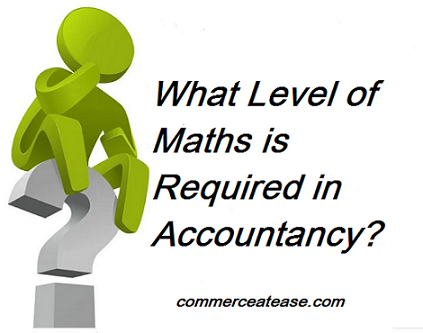
What Level of Maths is Required in Accountancy?
What Level of Maths is Required in Accountancy?
Students aspiring to take Accountancy subject have often this basic question in their mind. They have to use some simple mathematical calculations in Accountancy like:
In Class 11 - Addition, Subtraction, Multiplication, Division, Percentage.
In Class 12 - Additional requirement is to work with fractions.
In no way the calculation work should pose a threat to an aspiring student of Accountancy.
You just develop the love for numbers rather than having Fear for working with numbers. Fake it till you make it.
A Brief Lesson in Fractions:
Fractions represent parts of a whole. A fraction has two parts: a numerator (the top number) and a denominator (the bottom number).
For example, in the fraction 3/4, 3 is the numerator, and 4 is the denominator. It means you have 3 parts out of 4 equal parts of a whole.
Now, let's cover basic operations.
Adding and Subtracting Fractions:
To add or subtract fractions, the denominators must be the same. If they're not, find a common denominator.
- 1/4 + 3/4 = (1 + 3)/4 = 4/4 = 1
- 5/8 - 3/8 = (5 - 3)/8 = 2/8 = 1/4
- 2/7 - 3/7 = (2/7) - (3/7) = (2 - 3)/7 = -1/7
- 3/8 - 1/16 = (6/16) - (1/16) = 5/16
Multiplying Fractions:
Multiply the numerators together and the denominators together.
Example: 2/3×4/5=8/15
Dividing Fractions:
Multiply by the reciprocal of the second fraction (flip the numerator and denominator).
Example: 2/3÷6/7=14/18
It can be simplified by Dividing the numerator and denominator by the same digit e.g. 2 in this case. So, it makes this fraction 7/9.
A Brief Lesson in Decimals:
The decimal system is based on powers of 10. Each digit's place value represents a power of 10, moving from right to left.
Learn the Place Values in a number
In the number 257.14 the place of:
- 2 is 2×100 (hundreds place)
- 5 is 5×10 (tens place)
- 7 is 7×1 (ones place)
- 1 is 1/10 (tenths place)
- 4 is 4/100 (hundredths place)
Adding and Subtracting Decimals:
Align the decimal points and perform addition or subtraction as with whole numbers.
Example:
- 23 + 2.14=7.37
- 46 + 21.36 = 256.82
- 28 – 253.67 = 9621.61
- 28 – 253.6 = 9621.68
- 28 – 253.07 = 9622.21
Multiplying Decimals:
Multiply the numbers as if there were no decimals. The result's decimal place is the sum of the decimal places in the factors.
Example: 3.5×2.4 = 8.40 = 8.4
45.34 X 35.2 = 1595.968 = 1595.97 (if next digit is 5 or greater than 5, take the next digit to round off to two digits).
Dividing Decimals:
Move the decimal point in the divisor to make it a whole number. Move the decimal point in the dividend the same number of places.
Then, perform division.
A Brief Lesson in Percentages
12% means 12/100
15% of 375 means (15/100) X 375 = .15 X 375 = 56.25
Learn to solve the following step by step:
- 10% of 2368
- 20% of 39846
- 12.5% of 84500
- 7.5% of 56470
- 5% of 34964
- 2.5% of 48629
Let's solve each of the equations step by step:
- 10% of 2368 = 236.8
- 20% of 39846 = 20/100 of 39846 = 2/10 of 39846 = 2 × 3984.6 = 7969.2
- 5% of 84500 = 84500/8 = 10562.5
- 5% of 56470 = 75/1000 of 56740 = 3/40 of 56470 = (3*5647)/4 = 4235.25
- 5% of 34964 = 1/20 of 34964 = 34964/20 = 1748.2
- 5% of 48629 = 48629/40 = 1215.725
By now, you must have come to know the calculation requirements of Accountancy. Your calculation work will be fast with practice.
